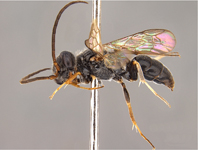Abstract
Kinorhyncha is a phylum of exclusively marine, meiofaunal invertebrates (Sørensen & Pardos 2008). Currently, the knowledge about the worldwide distribution of most of its species is considerably patchy, as several taxa have been reported from a single or few localities, usually within a limited geographic area (Sørensen & Pardos 2008; Yamasaki et al. 2018a). This even becomes more evident for deep-sea kinorhynchs, as noticed by Sørensen et al. (2018). Given the particular value of new records from the deep-sea to increase our understanding in the distribution of meiofaunal organisms plus the observed relationship of morphological variation through the bathymetric gradient, we aim to report the first record of Echinoderes unispinosus Yamasaki, Neuhaus & George, 2018 in the southern edge of the Gulf of Mexico (GoM), and contribute with new information about the morphological intraspecific variation of this species. In Mexico, studies of kinorhynch biodiversity are limited to the northern Gulf of California (50–1570m depth) (Álvarez-Castillo et al. 2015, 2018; Cepeda et al. 2019) and the Yucatán Peninsula (Sánchez & Martínez 2019). The GoM is a semi-closed basin located in a transition zone with both subtropical and tropical weather. Deep-sea muddy sediment samples of the present study were collected during the expedition XIXIMI-5 (10–24 June 2016) and processed according to Cisterna-Céliz et al. (2019). Kinorhynch specimens were mounted, measured and photographed according to Cepeda et al. (2019). Two adult males were identified as E. unispinosus, one from station B11 (2298 m depth) and another from station B15 (3708m depth). Kinorhynch specimens were deposited at the Aquatic Invertebrates Collection of the Facultad de Ciencias, Universidad Nacional Autónoma de México (UNAM), Mexico, under accession numbers: KGM.001 and KGM.002.
References
Álvarez-Castillo, L., Hermoso-Salazar, M., Estradas-Romero, A., Prol-Ledesma, R.M. & Pardos, F. (2015) First records of Kinorhyncha from the Gulf of California: horizontal and vertical distribution of four genera in shallow basins with CO2 venting activity. Cahiers de Biologie Marine, 56 (3), 271–281.
Álvarez-Castillo, L., Hermoso-Salazar, M., Estradas-Romero, A., Prol-Ledesma, R.M. & Pardos, F. (2018) New record of Fissuroderes thermoi (Kinorhyncha: Cyclorhagida) in the Gulf of California. Cahiers de Biologie Marine, 59 (3), 235–244.
Cepeda, D., Álvarez-Castillo, L., Hermoso-Salazar, M., Sánchez, N., Gómez, S. & Pardos, F. (2019) Four new species of Kinorhyncha from the Gulf of California, eastern Pacific Ocean. Zoologischer Anzeiger, 282, 140–160.
https://doi.org/10.1016/j.jcz.2019.05.011
Cisterna-Céliz, J.A., Marcelino-Barros, M., Herguera, J.C. & Rocha-Olivares, A. (2019) Metacommunity analysis of meiobenthos of deep-sea sediments from the Gulf of Mexico. Marine Biodiversity, 49 (3), 1217–1231.
https://doi.org/10.1007/s12526-018-0899-0
Sánchez, N. & Martínez, A. (2019) Dungeons and dragons: Two new species and records of Kinorhyncha from anchialine cenotes and marine lava tubes. Zoologischer Anzeiger, 282, 161–175.
https://doi.org/10.1016/j.jcz.2019.05.012
Sørensen, M.V. & Pardos, F. (2008) Kinorhynch systematics and biology - an introduction to the study of kinorhynchs, inclusive identifications keys to the genera. Meiofauna Marina, 16, 21–73.
Sørensen, M.V., Rohal, M. & Thistle, D. (2018) Deep-sea Echinoderidae (Kinorhyncha, Cyclorhagida) from the Northwest Pacific. European Journal of Taxonomy, 456, 1–75.
https://doi.org/10.5852/ejt.2018.456
Yamasaki, H., Grzelak, K., Sørensen, M.V., Neuhaus, B. & George, K.H. (2018a) Echinoderes pterus sp. n. showing a geographically and bathymetrically wide distribution pattern on seamounts and on the deep-sea floor in the Arctic Ocean, Atlantic Ocean, and the Mediterranean Sea (Kinorhyncha, Cyclorhagida). ZooKeys, 771, 15–40.
https://doi.org/10.3897/zookeys.771.25534
Yamasaki, H., Neuhaus, B. & George, K.H. (2018b) New species of Echinoderes (Kinorhyncha: Cyclorhagida) from Mediterranean seamounts and from the deep-sea floor in the Northeast Atlantic Ocean, including notes on two undescribed species. Zootaxa, 4387 (3), 541–566.
https://doi.org/10.11646/zootaxa.4387.3.8
Yamasaki, H., Neuhaus, B. & George, K.H. (2019) Echinoderid mud dragons (Cyclorhagida: Kinorhyncha) from Senghor Seamount (NE Atlantic Ocean) including general discussion of faunistic characters and distribution patterns of seamount kinorhynchs. Zoologischer Anzeiger, 282, 64–87.


